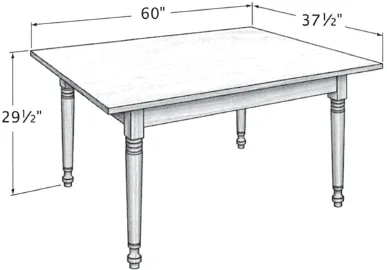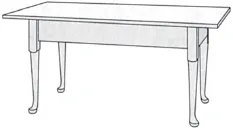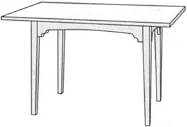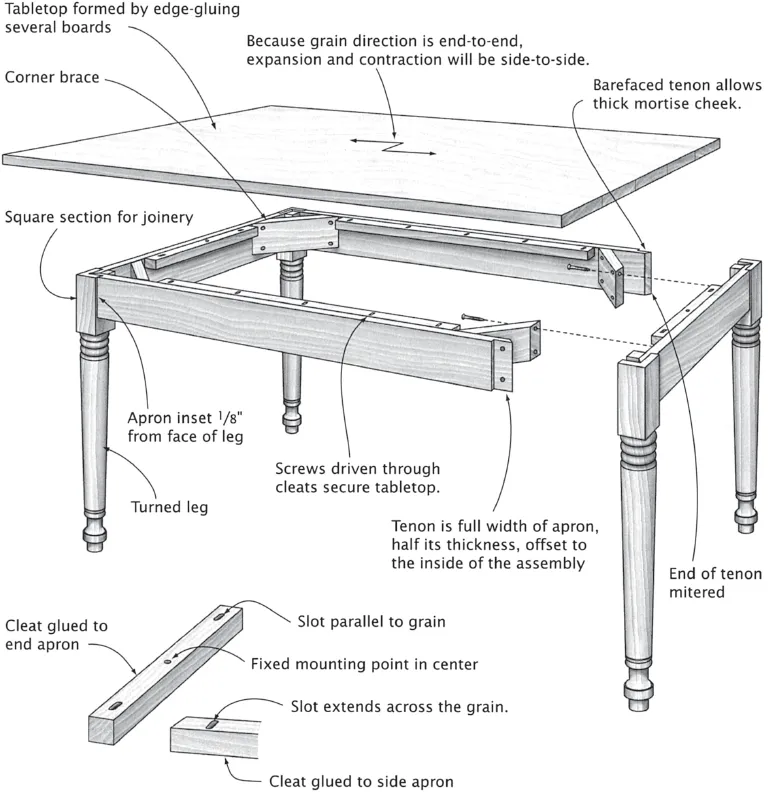![]()
FURNITURE
DINING TABLES
OCCASIONAL TABLES
DESKS
CHESTS
CABINETS
BUILT-IN CABINETS
BEDS
![]()
FURNITURE
DINING TABLES
It’s a perverse truism: The dining table that you remember best is typically the poorly designed one. The one that was too low or too high, the one that cramped your feet and legs, the one that wasn’t roomy enough. To help you design a table you’ll remember only for its appearance, here are basic standards.
TABLE HEIGHT: Distance from floor to top surface of the tabletop. Typically, this is 28 to 30 inches.
LEG ROOM: Distance from floor to lower edge of apron; a measure of the vertical space for your legs. The minimum space would be about 24 inches.
KNEE ROOM: Distance from table’s edge to a leg; a measure of the clearance provided for your knees when your chair is drawn up to the table. Minimums range from 10 to 16 inches; a good range would be 14 to 18 inches.
THIGH ROOM: Distance from chair seat to bottom edge of apron; a measure of the vertical space available for your thighs if you sit in a given chair, drawn up to the table. Minimum is 6½ inches.
ELBOW ROOM: Space allowance for each diner. The minimum seems to be 24 inches, but 30 inches is far better.
REACH: Depth allowance for each place setting. Less than 12 inches is too little; more than 18 inches is too much.
CHAIR ROOM: Space allowance between the tabletop’s edge and the wall for you to push your chair away from the table and stand up. The architects say 36 inches is the minimum; 44 inches is the optimum.
![]()
LEG-AND-APRON TABLE
Kitchen Table, Worktable
When you think table, don’t you think of a flat board supported on four legs? Don’t you think of a table like that shown above? That table is an archetype among archetypes.
In its most simple form, a table—the archetypal table—is formed of just three kinds of parts: the legs, the aprons, and the tabletop. The legs and aprons are joined to form a sturdy, but nonetheless open, support structure. Structurally speaking, many tables are leg-and-apron tables, though we very seldom call them that. We’re more likely to name them for the use we put them to or the place we keep them: kitchen table, bedside table, coffee table.
PLANS
Becksvoort, Chris. “Leg-and-Apron Table,” The Best of Fine Woodworking: Traditional Furniture Projects. Newtown, CT: The Taunton Press, 1991. A round-topped expanding table presented in tightly conceived drawings and how-I-built-it text.
Lynch, Carlyle. “Country Breakfast Table,” American Woodworker, Vol. IV, No. 2 (May/June 1988), pp. 46–49. A splendid Lynch measured drawing of a round-topped table, together with construction guidelines.
As you page on, you’ll see archetypes of all sorts of other tables, and many of them will refer back to this fundamental table.
This table is just the sort that would be found in a kitchen. Its bulk conveys a sense of sturdiness. While the legs are heavy, the turned profile reduces their bulk visually. Moreover, the generous dimensions of the leg posts make them ideal for strong joints.
DESIGN VARIATIONS
Despite the simplicity of the leg-and-apron table, endless varieties are possible. The table can be round, square, oval, or rectangular. Its legs can be square, turned, tapered, or sculpted. Even the aprons can alter the appearance of a table.
The round table, for example, has the same turned legs as the archetype table yet looks completely different. The square leg-and-apron assembly and the round tabletop give it that different look. Despite its elegant turned cabriole legs, the Queen Anne table, with its deep aprons, is clearly a worktable. The relieved aprons of the third table produce big visual and practical differences, making the table appear lighter and taller and at the same time offering increased thigh room.
Round-Topped Table
Queen Anne Worktable
Table with Relieved Aprons
Apron-to-Leg Joinery
Pilot Slots
![]()
TAVERN TABLE
Everyone has a slightly different vision of a tavern table. Furniture scholars usually describe it as a plain, low, oblong table on sturdy framework of turned or square legs and stretchers. That pretty much covers it: It’s a leg-and-apron table with stretchers.
Stretchers, particularly stout ones like those on the table shown, add a great deal of strength and rigidity to a table. When it is subjected to aggressive daily use, those stretchers can add years to its useful life. The name “...









